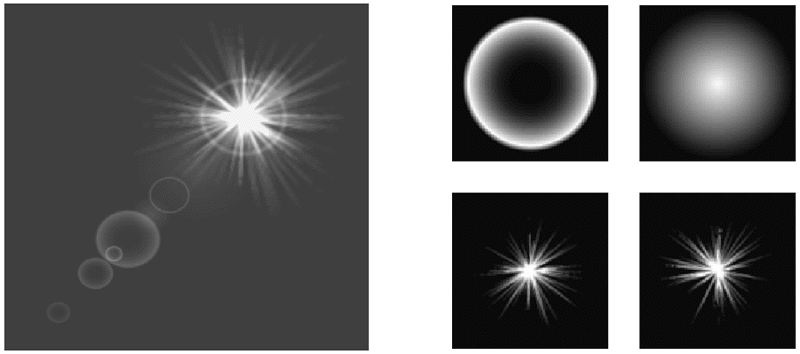11/10 - 11/12 @ Montréal, Canada
12/5 - 12/7 @ Shanghai, China
12/24 - 12/27
2/28 - 3/4 @ San Francisco, CA
More events...
2406 articles in the reference section.
Help us fight cancer!
Join SETI Team GDNet!
|
Chapter 6 Special Effects by Tomas Möller and Eric Haines
6.2.1 Lens Flare and BloomLens flare is a phenomenon that is caused by the lens of the eye or camera when directed at bright light. It consists of a halo and a ciliary corona. The halo appears because the lens material refracts light of different wavelengths by different amounts, as a prism does. The halo looks like a circular ring around the light, with its outside edge tinged with red, inside with violet. The ciliary corona is from density fluctuations in the lens, and appears as rays radiating from a point, which may extend beyond the halo [13]. Camera lenses can also create secondary effects due to parts of the lens reflecting or refracting light internally. For example, hexagonal patterns can appear due to the camera's diaphragm blades. Bloom is caused by scattering in the lens and other parts of the eye, giving a glow around the light and dimming contrast elsewhere in the scene. In video production, the video camera captures an image by converting photons to charge using a charge coupled device (CCD). Bloom occurs in a video camera when a charge site in the CCD gets saturated and overflows into neighboring sites. As a class, halos, coronae, and bloom are called glare effects. In practice what this means is that we associate these effects with brightness. Once thought of as relatively rare image artifacts, they are now routinely added digitally to real photos to enhance the effect. There are limits to the light intensity produced by the computer monitor, so to give the impression of increased brightness to a scene these glare effects are explicitly rendered. The lens flare effect is now something of a cliché due to its common use. Nonetheless, when skillfully employed it can give strong visual cues to the viewer; see plate XIV. Figure 6.3 shows a typical lens flare. It is produced by using a set of textures for the glare effects. Each texture is applied to a square that is made to face the viewer (i.e., is placed perpendicular to the view direction). The texture is treated as an alpha map, determining how much of the square to blend into the scene. Because it is the square itself which is being displayed, the square can be given a color (typically a pure red, green, or blue) for prismatic effects for the ciliary corona. These colored, textured squares are blended using an additive effect to get other colors. Furthermore, by animating the ciliary corona a sparkle effect is created [6].

|
||||||||||||
|
|
||||||||||||